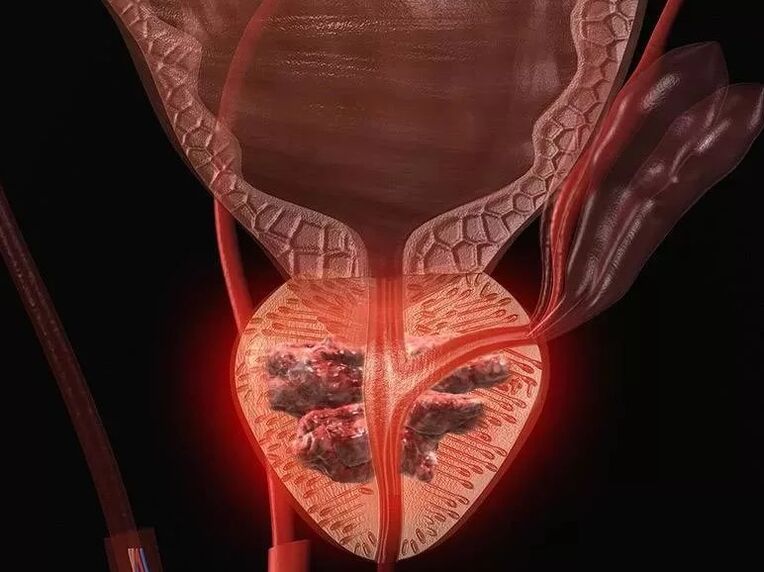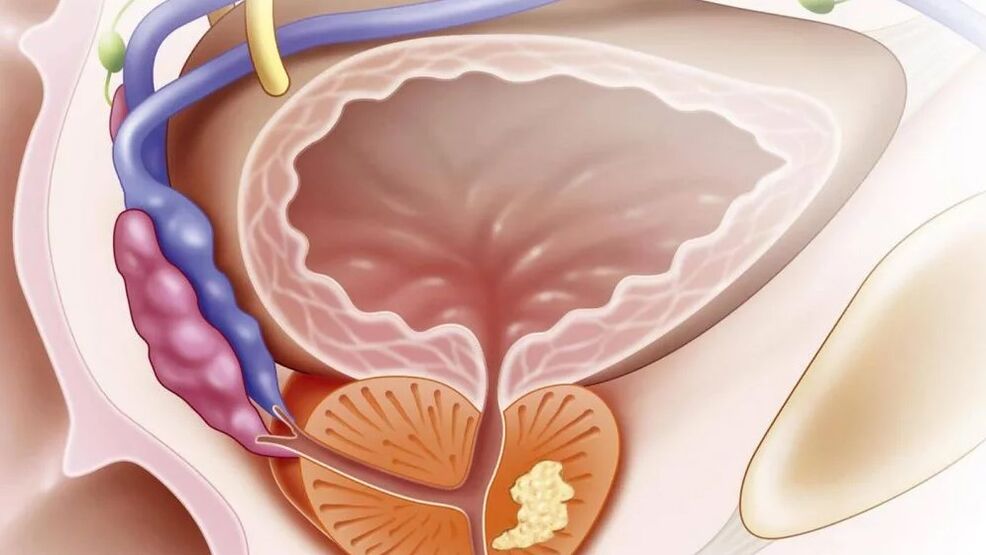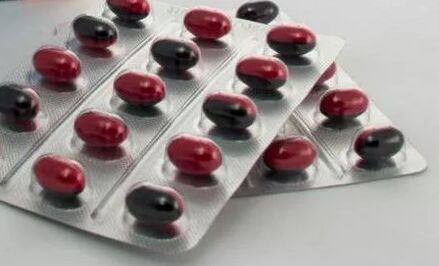One of the most dangerous complications for acute prostatitis can be the abscess of the prostate gland. This is a purulent inflammation of the focus, where body temperature can rise to 40 degrees. Signs of abscesses are acute intensive and severe pain. In the absence of medical care, swelling of the gland tissue and the lumen of the urethra is completely blocked.

Prostatitis is the most common urological pathology in reproductive men. According to the selection, each third of them at least in their lives experience symptoms that can be interpreted as inflammation of the prostate gland. The main cause of the development of bacterial prostatitis is infection, however, only in the case of acute prostatitis, infection leads to sharp inflammation of the prostate gland, which is explained by the anatomical features of the male body structure.
In the form of chronic prostatitis, infection can also be the cause, the mechanism of inflammation trigger, but the inflammation of the prostate gland, which requires treatment, can only develop with the background of other factors:
- Prolonged hypothermia of different properties: it can be a bath in the ice hole, or sit on cold stone, and so on;
- an inactive (inactive) lifestyle, leading to blood stagnation, which can also cause inflammation;
- Irregular sex life: this refers to both excessive abstinence and excessive activity;
- For example, urhritis, urethritis) or sexually transmitted diseases (gonorrhea, chlamydia, etc. -other): there is also the presence of hidden diseases -these diseases, the result of prostatitis;
- common problems with stools (most often chronic constipation);
- The use of spicy foods, smoke and citrus, alcohol and several other products can also cause inflammation of the prostate gland
- Other factors that cause immunity are affected: excessive load, double pressure or length.
Prostatitis: as a result
In the case of an urgent appeal to urologists, acute bacterial prostatitis can lead to the formation of abscesses and edema of the prostate gland, which can not only complicate the urine, but to make it completely impossible.
The latter, such as inflammation, can cause serious body intoxication, characterized, among others, with a sharp increase in temperatures up to 40-41 ° C (with sharp temperature fluctuations in 1 degree).
However, the most frequent complications like these can be avoided, as the manifestation of prostatitis This species usually forced the patient not to delay a specialist visit.
In the case of chronic diseases, the symptoms are unclear, the development of complications without proper and timely treatment is possible. Without proper drug and therapeutic effects, inflammation can spread to other organs of the genitourinary system, which can lead to development:
- Cystitis - bladder inflammation;
- pyelonephritis - kidney inflammation;
- vesiculitis - inflammation of the seed bubble;
- Penis inflammation and penis complement.

Keep in mind that egg and penis inflammation is one of the most common complications and can cause male infertility, which in turn is treated for a long time, difficult and unsuccessful, so that the faster treats prostatitis, more opportunities to avoid such complications.
In some cases, the consequences of chronic prostatitis may transition to the form of calculus. Calculus prostatitis is characterized by the formation of calculi (small gravel) in the gland excavation tract, to remove the very drug.
In addition, the cause of prostatitis is a hormone failure caused by inadequate hormone production with the sex gland.
The development of prostatitis is facilitated for a number of reasons. Often, signs of prostatitis are shown in people who carry out irregular sex life, often undergo hypothermia and injury.
In addition, prostatitis can develop due to decreased immunity, worsening blood flow and lymph circulation in the male pelvic male, due to hormone failure, which causes certain levels of androgynous failure.
Factors contributing to the manifestation of prostatitis are also considered several sexually transmitted infections. Therefore, prostatitis is often shown in men after unprotected intercourse.
There are 4 main forms of prostatitis: acute bacterial prostatitis, chronic bacterial prostatitis, prostatitis and prostatinia.
In people under 35, the disease is usually continued in the form of acute bacterial prostatitis. Bacterial prostatitis is called when there is a laboratory confirmation of the presence of infection.
Often, it turns out to be chlamydia, trichomoniasis, gardnerellosis or gonorrhea. Infections enter the prostate gland of the urethra, bladder, rectum, through the blood and lymph of the pelvic vessels.

However, these new studies have shown that in most cases, the infection is lined with disorders in the prostate tissue structure and blood circulation in it. With non -bacterial prostatitis, bacteria cannot be separated, although this does not exclude their presence.
In older patients, a form of chronic disease is more often diagnosed. Prostatodinia is called the presence of clinical picture of prostatitis, the seal of prostate tissue without signs of inflammation.
Classification
In line with the criteria of the National Institute of Health (NIH USA), four categories of prostatitis are distinguished from 1995:
- Acute prostatitis (bacteria)
- Chronic bacterial prostatitis
- Non -chronic prostatitis / chronic pelvic pain (CP / CPPS)
- Chronic pelvic pain syndrome (leukocytes is determined in prostate, urine and ejaculation)
- Chronic pelvic pain syndrome is not inflammated, where the signs of inflammation are absent
- Chronic prostatitis without symptoms
Currently, international classification of prostatitis has been adopted, most complete and covers all types of inflammation:
- Category I. acute prostatitis;
- Category ii. Chronic prostatitis bacteria;
- Category iii. Chronic prostatitis nebacterial/chronic pelvic pain syndrome is a disease in which the infection that lasts more than 3 months is not detected;
Sub -category III A. Chronic inflammatory pelvic pain syndrome (leukocyte is determined in prostate secret);
Subcategory III B. Non -chronic pelvic pain syndrome (no leukocytes in prostate secret); - Category IV. Speepomically continues with chronic prostatitis (leukocytes are present in prostate secrets, patients do not complain, the disease is detected by chance).
The treatment of prostatitis is different -depending on the form of the disease in a man. Therefore, bacterial prostatitis can occur in acute form and as a chronic disease.
Often, non -bacterial prostatitis is also diagnosed as a chronic disease. Various prostatitis is also known as chronic pelvic pain syndrome.
In such patients, all symptoms of prostatitis are observed, but there is no bacteria in the secret of the prostate.
Acute bacterial prostatitis is characterized by rapid development. At the same time, a person suffers from severe pain, there are signs of general intoxication. Symptoms in the chronic form of the disease are less clear. In this case, the disease shows gradually.
And if the acute form of prostatitis, as a rule, ends with the complete healing of the disease, then with chronic prostatitis, the relapse appears quite frequently. This should be taken into account in the treatment of prostatitis at home. In addition, with the presence of stones that are inflamed in the prostate gland, this disease therapy is a more complex process.

With non -bacterial prostatitis (chronic pelvic pain), a person has severe illnesses in the pelvis, genitalia, and perineum. There are no signs of inflammation in the prostate.
The disease is common in modern men from different age groups, but most often the disease affects people 35-45 years old. To this day, experts have expressed some assumptions about what is the cause of this form of prostatitis.
Therefore, there is a theory that this syndrome causes damage to bacterial prostate tissue. In addition, there is an opinion that the disease is indicated because the urine falls into the prostate gland.
As we have said, acute and chronic illness is possible. In this case, the emergence of acute prostatitis is most frequently provoked by gram-negative bacteria.
The form of the disease is relatively easy to diagnose and treat by taking antibiotics. At the same time, cases of non -chronic prostatitis are very often found in men, which are more difficult to diagnose and have nothing to do with certain infectious lesions.
Therefore, in the case of chronic prostatitis, treatment with antibiotics will not have the right effect. According to statistics, about 35% of men over the age of fifty, chronic prostatitis.
Treatment of chronic and acute prostatitis
In the case of signs of prostatitis, both acute and chronic, you should consult a urologist, who will establish what kind of diagnosis is that occurs, and also help cure the disease and strengthen the body as a whole. Keep in mind that this occurs equal to both types of prostatitis, which can lead to complications.
Major acceptance
The main receipt of the specialist involves the patient's review and examination (including the rectum, which allows you to determine the level and properties of the prostate gland improvement), as well as the appointment of the necessary tests and other diagnostic measures.
The first and important sign of prostatitis is urinary tract disorders that cause discomfort. Another sign of the disease is fast urine, but where urina comes out in small parts.
Symptoms of an acute form of illness

The disease is formed suddenly and characterized by clear manifestations.
- painful diarrhea;
- pain during drainage;
- potential affected;
- pain in the thighs, in the sacrum and anal zones;
- high sweating;
- Fatigue.
Each male body is an individual, and symptoms can be clearly separately, or at once.
Signs -The form of chronic disease
Chronic prostatitis is usually characterized by the same signs, however, it is followed by less obvious symptoms.
In addition, the following manifestations can be observed:
- increased irritation;
- Excessive bladder feelings;
- quality deterioration, or lack of orgasm;
- Selection during drainage from the urethra.
The first signs of prostatitis, in which a man should pay attention and contact the urologist:
- Severe pain during urination. At the end of the process, unpleasant burning sensations are felt.
- Increase body temperature.
- Feelings do not completely clear the bladder.
- Discomfort in the crotch and thigh area.
- Insufficient jet pressure while visiting the toilet.
The treatment of prostatitis is performed depending on the form of the disease. Acute inflammation is a clue to admission to a patient hospital at a urological hospital, with chronic patients undergoing a home therapy course. If the cause of the disease is a sexual infection, both couples should take antibiotics.
In the treatment of acute prostatitis, it is important that systemic antibacterial treatment is important.

The main group of drugs includes:
- Antibiotics. Used in the form of tablets, capsules, candles, syrups and other types.
- Anti -inflammation.
- Spasmalgotics and analgesics.
- Preparation to increase immunity.
- Vitamins.
- Antistress medicine.
Massage
This procedure is one of the most effective methods for treating prostatitis. Thanks to him, accumulated in the prostate gland, the secret was squeezed out of it, and then freely removed through the urethra. In addition, the prostate massage helps increase blood supply to the gland tissue, which improves the effectiveness of antibacterial and local therapy.
Physiotherapy
Physiotherapy treatment helps increase trofism of prostate gland tissue and accelerates the recovery process. The following physiotherapy methods are possible:
- Transrectal microwave hyperthermia,
- Adedinamophoresis,
- Laser therapy,
- Ultrasonic phonophoresis.
Training
The main sign of the disease
Diseases such as prostatitis in most men develop suddenly. In patients, temperatures rise significantly, feelings of weakness, fever appear. The main sign of prostate inflammation is intense pain in the perineum, which gives to the genital area, anal opening, sacrum. During urination, drainage and other tension -pelvic muscle, pain increases.






























